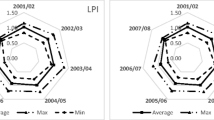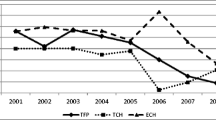Abstract
The assessment of productivity change over time and its drivers is of great significance for water companies and regulators when setting urban water tariffs. This issue is even more relevant in privatized water industries, such as those in England and Wales, where the price-cap regulation is adopted. In this paper, an input-distance function is used to estimate productivity change and its determinants for the English and Welsh water-only companies (WoCs) over the period of 1993–2009. The impacts of several exogenous variables on companies’ efficiencies are also explored. From a policy perspective, this study describes how regulators can use this type of modeling and results to calculate illustrative X factors for the WoCs. The results indicate that the 1994 and 1999 price reviews stimulated technical change, and there were small efficiency gains. However, the 2004 price review did not accelerate efficiency change or improve technical change. The results also indicated that during the whole period of study, the excessive scale of the WoCs contributed negatively to productivity growth. On average, WoCs reported relatively high efficiency levels, which suggests that they had already been investing in technologies that reduce long-term input requirements with respect to exogenous and service-quality variables. Finally, an average WoC needs to improve its productivity toward that of the best company by 1.58%. The methodology and results of this study are of great interest to both regulators and water-company managers for evaluating the effectiveness of regulation and making informed decisions.


Similar content being viewed by others
Notes
Interested readers can consult the Regulatory accounting guidelines 2016–2017 published by Ofwat at its webpage: www.ofwat.gov.uk/wp-content/uploads/2016/10/prs_in1609RAG1617.pdf
In our model, 77% of the observations satisfy quasi-concavity in output, while 56 observations (23%) violate this condition.
References
Ananda J (2014) Evaluating the performance of urban water utilities: robust nonparametric approach. J Water Resour Plan Manag 140(9):04014021
Ashton JK (2008) Capital utilisation and scale in the English and Welsh water industry. Serv Ind J 23(5):137–149
Bottasso A, Conti M (2009a) Price cap regulation and the ratchet effect: a generalised index approach. J Prod Anal 32(3):191–201
Bottasso A, Conti M (2009b) Scale economies, technology and technical change: evidence from the English water only sector. Reg Sci Urban Econ 39(2):138–147
Bottasso A, Conti M, Piacenz M, Vannoni D (2011) The appropriateness of the poolability assumption for multiproduct technologies: evidence from the English water and sewerage utilities. Int J Prod Econ 130(1):112–117
Brea-Solis H, Perelman S, Saal DS (2017) Regulatory incentives to water losses reduction: the case of England and Wales. J Prod Anal In press
Carvalho P, Marques RC (2011) The influence of the operational environment on the efficiency of water utilities. J Environ Manag 92(10):2698–2707
CEPA (2014). Cost assessment—advanced econometric models. Cambridge Economic Policy Associates Ltd, Report prepared for Ofwat
Coelli TJ, Estach A, Perelman S, Trujillio L (2003) A primer on efficiency measurement for utilities and transport regulations. WBI development studies. The World Bank, Washington, D.C.
De Witte K, Marques RC (2010) Influential observations in frontier models, a robust non-oriented approach to the water sector. Ann Oper res 181(1):377–392
Färe R, Primont D (1995) Multi-output production duality: theory and applications. Kluwer Academic Publications, Boston
Färe R, Martins-Filho C, Vardanyan M (2010) On functional form representation of multi-output production technologies. J Prod Anal 33(2):81–96
Greene W (2005) Fixed and random effects in stochastic frontier models. J Prod Anal 23(7):7–32
Jabran K, Hussain M, Fahad S, Farooq M, Alharrby H, Nasim W (2016) Economic assessment of different mulches in conventional and water-saving rice production systems. Environ Sci Pollut res 23(9):9156–9163
Kumbhakar SC, Wang H-J, Horncastle A (2015) A practitioner’s guide to stochastic frontier analysis using STATA. Cambridge University Press
Marques RC (2011) Regulation of water and wastewater services: an international comparison. IWA publishing
Marques RC, Berg S, Yane S (2014) Nonparametric benchmarking of Japanese water utilities: institutional and environmental factors affecting efficiency. J Water Resour Plan Manag 140(5):562–571
Maziotis A, Saal DS, Thanassoulis E, Molinos-Senante M (2015) Profit, productivity and price performance changes in the water and sewerage industry: an empirical application for England and Wales. Clean Techn Environ Policy 17(4):1005–1018
Maziotis A, Saal DS, Thanassoulis E, Molinos-Senante M (2016a) Price cap regulation in the English and Welsh water industry: a proposal for measuring performance. Util Policy 41:22–30
Maziotis, A., Molinos-Senante, M., Sala-Garrido, R. (2016b). Assessing the impact of quality of service on the productivity of water industry: a Malmquist-Luenberger productivity index approach for England and Wales. Water Resour Manag in Press doi:10.1007/s11269-016-1395-6
Mellah T, Ben Amor T (2016) Performance of the Tunisian water utility: an input-distance function approach. Util Policy 38:18–32
Molinos-Senante M, Sala-Garrido R (2016) Performance of fully private and concessionary water and sewerage companies: a metafrontier approach. Environ Sci Pollut res 23(12):11620–11629
Molinos-Senante M, Maziotis A, Sala-Garrido R (2014) The Luenberger productivity indicator in the water industry: an empirical analysis for England and Wales. Util Policy 30:18–28
Molinos-Senante M, Maziotis A, Sala-Garrido R (2015a) Assessing the relative efficiency of water companies in the English and welsh water industry: a metafrontier approach. Environ Sci Pollut res 22(21):16987–16996
Molinos-Senante M, Sala-Garrido R, Lafuente M (2015b) The role of environmental variables on the efficiency of water and sewerage companies: a case study of Chile. Environ Sci Pollut res 22(13):10242–10253
Molinos-Senante M, Maziotis A, Sala-Garrido R (2016a) Assessment of the total factor productivity change in the English and Welsh water industry: A Fare-Primont productivity index approach. Water Resour Manag In press. doi:10.1007/s11269-016-1346-2
Molinos-Senante M, Maziotis A, Sala-Garrido R (2016b) Estimating the cost of improving service quality in water supply: a shadow price approach for England and Wales. Sci Total Environ 539:470–477
O’Donnell CJ, Coelli TJ (2005) A Bayesian approach to imposing curvature on distance functions. J Econ 126:493–523
Ofwat (1994) Future charges for water and sewerage services. Office of Water Services, Birmingham
Ofwat (1999) Future water and sewerage charges 2000–2005; final determinations. Office of Water Services, Birmingham
Ofwat (2004a) Levels of service for the water industry in England & Wales 2003–2004 report. Office of Water Services, Birmingham
Ofwat (2004b) Future water and sewerage charges 2005–10: final determinations. Available from: http://www.ofwat.gov.uk/pricereview/pr04/det_pr_fd04.pdf
Ofwat (2005a) Water and sewerage service unit; costs and relative efficiency 2004–2005 report. Office of Water Services, Birmingham
Ofwat (2005b) Levels of service for the water industry in England & Wales 2004–2005 report. Office of Water Services, Birmingham
Ofwat (2007) Levels of service for the water industry in England & Wales 2006–2007 report. Office of Water Services, Birmingham
Ofwat (2009a) Levels of service for the water industry in England & Wales 2008–2009 report. Office of Water Services, Birmingham
Ofwat (2009b) Accounting separation-consultation on June return reporting requirements 2009–10. The water services regulation authority. Birmingham
Orea L (2002) A parametric decomposition of generalized Malmquist productivity index. J Prod Anal 18(1):5–22
Pinto FS, Simoes P, Marques RC (2016) Water services performance: do operational environmental and quality factors account? Urban Water J In press
Portela MCAS, Thanassoulis E, Horncastle A, Maugg T (2011) Productivity change in the water industry in England and Wales: application of the meta-malmquist index. J Oper Res Soc 62(12):2173–2188
Saal DS, Parker D (2000) The impact of privatization and regulation on the water and sewerage industry in England and Wales: a translog cost function model. Manag Decis Econ 21(6):253–268
Saal DS, Parker D (2001) Productivity and price performance in the privatized water and sewerage companies in England and Wales. J Regul Econ 20(1):61–90
Saal DS, Parker D (2006) Assessing the performance of water operations in the English and Welsh water industry: a lesson in the implications of inappropriately assuming a common frontier. In: Coelli T, Lawrence D (eds) Performance measurement and regulation of network utilities. Edward Elgar, Cheltenham
Saal DS, Reid S (2004) Estimating OPEX productivity growth in English and Welsh water and sewerage companies: 1999–2003. RP0434. Aston Business School Research Papers
Saal DS, Parker D, Weyman-Jones T (2007) Determining the contribution of technical efficiency, and scale change to productivity growth in the privatized English and Welsh water and sewerage industry: 1985–2000. J Prod Anal 28(1):127–139
Saal DS, Arocena P, Maziotis A (2011) Economies of integration in the English and Welsh water only companies and the assessment of alternative unbundling policies. ACCIS Working Paper, No 7
See KF (2015) Exploring and analysing sources of technical efficiency in water supply services: some evidence from southeast Asian public water utilities. Water Resour Econ 9:23–44
Simon CP, Blume L (1994) Mathematics for economists. W.W. Norton & Company, New York, London, New York
Torres M, Morrison PC (2006) Driving forces for consolidation or fragmentation in the US water utility industry: a cost function approach with endogenous outputs. J Urban Econ 59:104–120
Wales TJ (1977) On the flexibility of functional forms: an empirical approach. J Econ 5(2):183–193
Wolf H, Heckelei T, Mittelhammer RC (2010) Imposing curvature and monotonicity on flexible functional forms: an efficient regional approach. J Comput Econ 36(4):309–339
Worthington AC (2014) A review of frontier approaches to efficiency and productivity measurement in urban water utilities. Urban Water J 11(1):55–73
Author information
Authors and Affiliations
Corresponding author
Additional information
Responsible editor: Philippe Garrigues
Rights and permissions
About this article
Cite this article
Molinos-Senante, M., Porcher, S. & Maziotis, A. Impact of regulation on English and Welsh water-only companies: an input-distance function approach. Environ Sci Pollut Res 24, 16994–17005 (2017). https://doi.org/10.1007/s11356-017-9345-2
Received:
Accepted:
Published:
Issue Date:
DOI: https://doi.org/10.1007/s11356-017-9345-2




